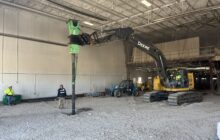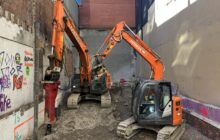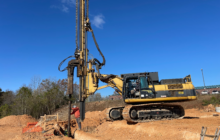Ductile Iron Piles Provide Economical Alternative To Drilled Micropiles
Project Description:
The waterfront Red Bank Marine Park Improvements project included construction of a new pump station. The design featured an 11.5-ft by 16.5-ft pile-supported mat foundation to support the structure and equipment. Foundation bearing was approximately 16 feet below the existing grade.
Geotechnical Conditions:
Geotechnical explorations encountered very soft silt and clay extending about 55 feet below grade followed by loose clayey sand to 70 feet. Below 70 feet, medium dense to dense clayey sand and very stiff silt was encountered to more than 120 feet. Groundwater was around 5 feet below grade. Moving across the site away from the water, the very dense / stiff soils were encountered at much shallower depths.
Project Challenges:
Provide an economical alternative to drilled micropiles for pump station support.
Advantages
- Substantial cost savings compared to drilled micropiles
- Rapid installation
- Low vibrations in residential area
- Verifiable performance with load testing
- Load-carrying capacity that exceeds design requirements
Design and Construction Solution:
Original pump station support featured a total of nine 8-inch diameter hollow-bar micropiles cased to depths of at least 43 feet below the foundation followed by a bond zone in the dense conditions. Pile working loads were specified as 20 tons (compression) and 1 ton (lateral). After a round of bidding, the micropile option proved to be too expensive. Engineers at T & M Associates worked with DuroTerra to develop an alternative foundation option consisting of friction Ductile Iron Piles. Revised project bid documents were released with the base micropile option and an approved Ductile Iron Pile alternative.
Precise Construction, Inc. was awarded the project. After pricing the specified options and other alternatives, the Ductile Iron Pile (DIP) alternative was selected based on cost savings, installation time and ease of installation. Helical Drilling’s submittal was prepared consistent with the specified DIP design using Series 170/9.0 piles installed with a 270 mm conical cap to create a 10-inch diameter grouted friction pile. The piles were designed to penetrate through the soft soils and develop a minimum 10-ft bond in the dense underlying soils. Plans also required pile joints (bell-spigot) be located at least 12 feet below the foundation base.
Two non-production tension load tests were installed a short distance (towards the water) from the pump station location from a working grade near the ground surface (approximately 16 ft above the footing bottom). The piles penetrated to 72 feet before encountering the stiff zone and then advanced to construct the 10 foot bond zone for a total length of 82 feet. Load testing was performed up to 250% of the design load and recorded deflections of less than 0.2 inches at 250% (100 kips).
The nine production piles were installed in only one day following successful load testing. During installations, the depth to the dense layer decreased across the area moving away from the water’s edge. As a result, pile construction was carefully managed to meet the minimum bond length while also avoiding a joint within 12 feet of the footing base. Following installation from the higher working grade, the pump station area was excavated, piles were cut and capped and the foundation was poured.
Project Team Members
DIP Sales Partner: GeoStructures, Inc.
DIP Design/Build Partner: Helical Drilling, Inc.
Geotechnical Engineer: T&M Associates, Inc.
General Contractor: Precise Construction, Inc.
Structural Engineer: T&M Associates, Inc.





